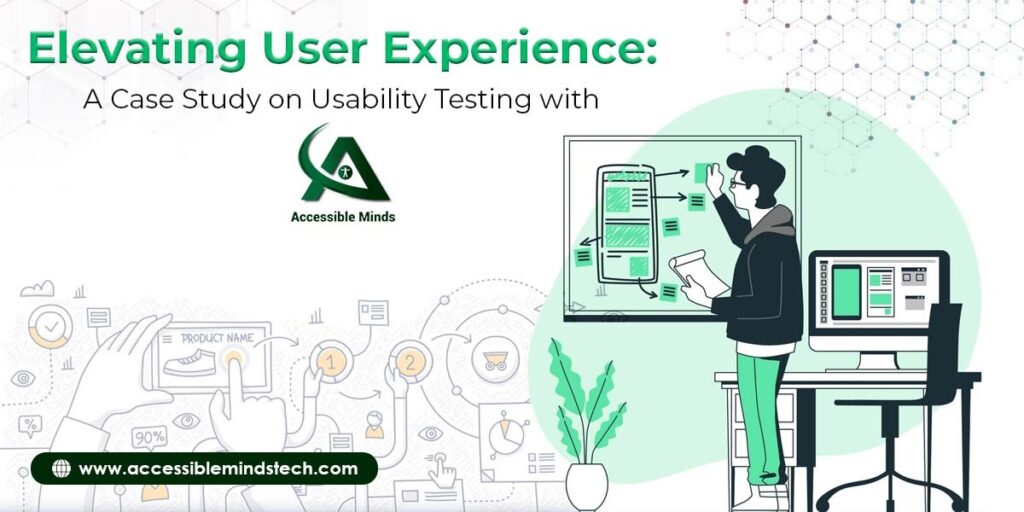Introduction:
Usability testing is a critical component of product development, ensuring that digital products and services are user-friendly, efficient, and accessible. In this case study, we delve into how Accessible Minds helped a product owner optimize their digital platform through effective usability testing. We’ll explore the challenges faced by the product owner, the solutions provided by Accessible Minds, and the benefits derived from this collaborative effort.
The Challenge:
Our client, a startup founder, had developed a web-based platform for e-learning. However, they were encountering challenges related to user engagement, high bounce rates, and low user satisfaction. It became apparent that their platform required a more user-centric design to address these issues.
The Solution- Usability Testing with Accessible Minds:
To address these challenges, our client approached Accessible Minds for their expertise in usability testing. Accessible Minds developed a comprehensive usability testing plan to evaluate the platform’s user interface and overall user experience. The following steps were undertaken:
- Test Participant Recruitment: Accessible Minds identified a diverse group of potential users, reflecting the platform’s target audience. This group included Visually Impaired Users, students, teachers, and parents, ensuring a well-rounded perspective.
- Testing Environment Setup: A controlled and replicable testing environment was established to observe user interactions with the platform. This environment included usability testing software and equipment to record user actions and feedback.
- Testing Sessions: Participants including Visually Impaired Users were asked to perform specific tasks on the platform while providing real-time feedback. Their interactions, including clicks, navigation, and comments, were recorded and analyzed.
- Data Analysis: Accessible Minds collected and analyzed data from these sessions to identify usability issues, pain points, and areas where the platform excelled.
- Recommendations and Reporting: A detailed report was provided to the product owner, summarizing the findings and outlining actionable recommendations for improving the platform’s usability.
The Benefits:
The collaboration between the product owner and Accessible Minds yielded several significant benefits:
- Enhanced User Experience: Usability testing revealed critical pain points and obstacles in the user journey. The product owner was able to address these issues promptly, resulting in a significantly improved user experience.
- Reduced Bounce Rates: By making the platform more intuitive and user-friendly, the product owner witnessed a remarkable reduction in bounce rates. Users were more likely to engage with the platform and explore its offerings.
- Increased User Satisfaction: The improvements implemented following usability testing led to higher user satisfaction levels. Positive user feedback and reviews began to pour in, bolstering the platform’s reputation.
- Higher Conversion Rates: With a more user-centric design, the platform’s conversion rates also saw a notable increase. Users were more likely to sign up for courses and spend more time on the platform.
- Time and Cost Savings: Identifying and rectifying usability issues early in the development process helped the product owner save time and resources that would have otherwise been spent on post-launch modifications and bug fixes.
- Competitive Edge: A user-friendly platform gave our client a competitive edge in the e-learning market, attracting more users and gaining market share.
- Confidence in Product Evolution: The product owner gained confidence in their product’s evolution by investing in user-centric design and usability testing. They now have a reliable process for continuous improvement and innovation.
Conclusion:
Thus, recognizing the importance of inclusivity, Accessible Minds went beyond traditional usability testing to ensure the e-learning platform’s accessibility for all users. A distinctive aspect of our approach involved conducting accessibility testing with visually impaired users. This step aimed to guarantee that the platform met the needs of individuals with diverse abilities. Screen readers, keyboard navigation, and other assistive technologies were employed during these sessions to simulate the experience of users with visual impairments. Insights gained from these tests provided invaluable feedback on the platform’s compatibility with accessibility standards, allowing for targeted enhancements to improve the user experience for this demographic. The inclusive approach not only aligned with ethical design practices but also broadened the platform’s reach, reinforcing the client’s commitment to providing an accessible and equitable learning environment for all.

